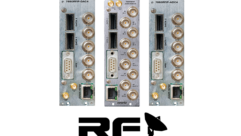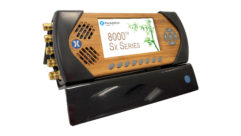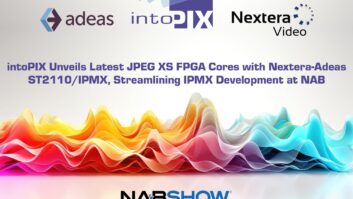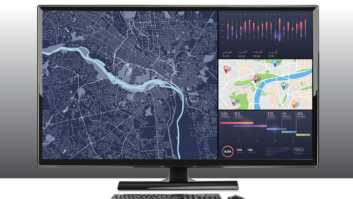
Technology Showcase:
Video Test Equipment
Dec 1, 2005 12:00 PM,
By Jay Ankeney
Portable test equipment ensures precise calibration of video installations.
When Vladimir Zworykin demonstrated RCA’s fledgling television system at the New York World’s Fair in 1939, setting up the display equipment to satisfy the engineers was truly a cutting-edge technological challenge. But satisfying the great unwashed audience was relatively simple. After all, to the eyes of viewers who didn’t know what to expect, the marvel of black-and-white moving pictures transmitted over distance appeared miraculous enough.
Hall Research DVC-3
Modern audiences, however, are accustomed to viewing high-quality, full-color images on sophisticated, high-definition screens in homes and commercial and public venues. So the job of the AV contractor who installs digital displays in corporate or industrial environments has become far more demanding. Fortunately, there are guidelines.
Today we have a generally agreed-upon method of specifying the way the components of color — luminance, chrominance and hue — are perceived. It all began more than 90 years ago, when the International Commission on Illumination (abbreviated as CIE from its French title “Commission Internationale de l’Eclairage”) set out to turn our human perception of color into mathematics. Its first major result, the 1931 “Colour Standard Table,” charts the red, green, and blue color responsivity of the human eye. These factors are represented as X/Y/Z values (written in uppercase) on a skewed horseshoe-shaped curve. Derived from a series of experiments performed by W. David Wright in 1928 and John Guild in 1931, this is referred to as a “color space.”
Actually, the CIE’s intention was to promote the understanding of colors by using 2D maps. Therefore, in order to omit one dimension, three new variables, x, y, and z (written in lowercase), were derived from the three measured values of X, Y, and Z by dividing each of these numbers by their total sum: x = X/(X + Y + Z). That means only two of the new values remain independent, and these can be expressed by having the horizontal axis represent the values for x, and the vertical axis the values for y.
The CIE’s standard valency system or “chromaticity diagram” is based on perceptual-physiological measurements, and although it’s been revised several times, its basic concepts have served well over the years. That’s because it represents an international consensus for color identification based on the additive mixing of light.
This has given AV contractors a method of measuring color imagery that is even more accurate than their own eyes. More importantly, it can be duplicated between different systems and quantified to satisfy the requirements of even the most demanding clients. As a result, a growing array of portable image calibration equipment is available. An installer’s humanly fallible eyes do not have to be the sole judge.

DisplayMate Multimedia Edition
THE MARKET
Model 1253 from B&K Precision is a cost-efficient portable high-definition multi-standard pattern generator that can display, from its HDTV component (YPbPr) outputs, 14 of the most useful patterns for 12 of the most commonly used video formats. Model 1253 also provides an “Overscan DVD Aspect Ratio Pattern” feature that covers the aspect ratios used for all movies recorded to DVD media. B&K Precision also offers Model 1211E for NTSC displays.
ColorVision, a division of Datacolor, purchased the ColorFacts Professional 6 calibration software from Milori about a year ago. Running on Windows laptops, ColorFacts Pro integrates directly with test image DVDs, including those from Avia, Video Essentials, and the PF Test Disc, providing a wizard-based color measurement tool for optimizing LCD, RPTV, front projector, plasma, or direct-view sets. ColorFacts works in conjunction with ColorVision’s SpyderTV sensor, a three-armed module that attaches to the front of a screen. It uses a USB cable to analyze the test patterns produced by the DVD and produces a report that can be provided to the installer’s client.
Some digital display test systems make you sit close to the front of the screen to make adjustments. But the HDTV-2 multimedia generator from Compuvideo Test Instruments comes with a complete remote control, letting you calibrate the screen from a normal 15ft. to 20ft. viewing distance. It provides HD or SD signals in either 4:3 or 16:9 aspect ratios, and 10 test patterns along with full field bars, SMPTE bars, black grayscale, red, green, blue, white, crosshatch, center cross, and dots. You can also connect VGA or SVGA inputs directly into the back of the HDTV-2 multimedia generator to calibrate the PC/Mac visual components of a boardroom presentation.
Beginning in the early 1990s, DisplayMate Technologies pioneered the use of specialized diagnostic test patterns for display setup, calibration, and testing. The company produced all of the test patterns used at the InfoComm Projection Shootout from 1996 until the event ended in 2002, and these are all now available in the software for Windows laptops. Since the patterns are generated in realtime from scale-free mathematical equations, they can be presented at any resolution in any aspect ratio. The current DisplayMate Multimedia Edition includes 300 advanced patterns, plus 200 additional variations for a total of more than 500 test patterns.

Extron VTG 400
Just last month, Doremi Labs began shipping its new HDG-20 HD and SD video test generator to replace its popular HDG-10 model. Among the new features are synch input to genlock the unit to an external synch source, a PC and Mac software GUI for serial remote control, and new video patterns. The HDG-20 even offers a dual-link HD-SDI video output at 2k resolution, and its flash E-Prom memory provides for hassle-free updates from Doremi’s website. A special feature of the HDG-20 is its ability to combine any still pattern with a moving pattern to create hundreds of video pattern options.
Though ultra-compact, the DVI test pattern generator from DVIGear produces the 15 most popular test patterns developed by Sencore. The unit supports both analog (RGBHV and YPbPr) and digital outputs via the single DVI-I port, enabling multiple displays to be tested with the same box. All models are 12V AC powered.
Having earned its reputation during the days of analog CRT alignment, Extron Electronics is now offering the VTG 300 handheld, battery-operated video and audio test generator featuring high-resolution computer video, plasma, HDTV, and 16:9 rates as well as standard-definition NTSC or PAL signals. The VTG 300 has a backlit LCD display and rubber push-buttons for direct and simple access to video and audio functions. Its 13 video test patterns can be used with any of the 34 video scan rates. Extron also offers the VTG 400, which makes 98 output scan rates available for high-resolution computer video screens as well as for HDTV, NTSC, and PAL displays. An innovative feature of the VTG 400 is the patent-pending Scope-Trigger output, which enables analysis of a selected area within the video image on an oscilloscope. Extron’s VTG 400D model has an SDI/HD-SDI output.

B&K Precision Model 1253
In addition to industrial installations, Fluke concentrates on the high demands of displays for the medical field. In addition to video, the Fluke 54000 series offers extensive data capabilities. A host of test signals are available: Teletext (TOP, FLOF, and VPT); Antiope; WideScreen Signalling (WSS); Program Delivery Control (PDC); Video Program System (VPS); and Closed Caption. The Fluke 54100 video signal generator provides support for TV, VCR, and video monitor testing in all the PAL, NTSC, and SECAM analog video standards. The Fluke 54200 TV signal generator offers additional sound tests and a stable RF output covering the entire RF frequency range from 32MHz to 900MHz, with a maximum output level as high as 100mV at any carrier frequency.
Hall Research Technologies is expanding its product line with the Model DVC-3 (Digital Video Coach-3), a video test pattern generator for LCD, plasma, and CRT monitors, and projectors equipped with PC, component, or DVI inputs. The DVC-3 provides DVI, PC (VGA through SXGA), and HDTV outputs from 480p to 1080i in both DVI digital and YPbPr formats. It also features 28 static and dynamic video test patterns specially designed for testing, calibrating, and troubleshooting high-end video gear and AV installations.
Joe Kane Productions, a company specializing in training and consulting on display standards, has released the six-disc Digital Video Essentials: Professional Edition set. Four of the discs are standard-definition DVDs containing test patterns in NTSC and PAL, and two are HD DVD discs produced and mastered in the 1920×1080 progressive video format. The HD discs are compatible with systems employing the HD color matrix described in Rec. ITU-R BT.709-4. The set is also sponsored and distributed by Extron Electronics.

Leitch Videotek PTM-305
Using spectral characteristics corresponding to the sensitivity of the human eye, the new Chroma Meter CS-200 — a spectrally based, handheld colorimeter from Konica Minolta — measures the luminance, chromaticity, gamma, and contrast of displays such as large flat-panel and plasma displays, compact LCDs, and OLEDs. CS-200’s accuracy is achieved by a “spectral fitting” method that uses 40 sensors to make detailed measurements over a wide range of light and color levels. In addition, the Konica Minolta CL-200 light source chroma measurement system (which replaces its CL-100) can perform measurements of tri-stimulus colorimetrics, chromaticity, color difference, correlated color temperature, and illuminance of light sources.
Well known for rack-mounted broadcast equipment, Leitch acquired Videotek last year. The Videotek PTM-305 is Leitch’s first foray into truly portable, multi-function video test signal generation. About the size of a PDA, the PTM-305 includes a video test signal generator; a color monitor; and waveform, vectorscope, and audio analyzer/monitor functions while simultaneously producing composite analog and SD-SDI signals. The PTM-305 has two video inputs: one for monitoring composite analog NTSC and PAL video signals, and the second for monitoring SD-SDI signals formatted in SMPTE 259M with embedded audio. Its color 320×240 LCD display offers touchscreen navigation.
The MM-410 from Magni Systems is a rasterizing NTSC/PAL and multiformat monitor with a unique split-screen mode that provides picture, waveform, and vectorscope on a single display. Other features, such as the SC/H and blanking graticule, facilitate advanced measurements. The MM-410’s 10 memory settings provide instant setup recall for specific monitoring modes. For real-world relevance, Magni Systems’ patented raster technology with 10-bit signal processing lets the MM-410 provide accurate waveform and vector displays on a standard color CRT picture monitor.
The PR-650 SpectraColorimeter from Photo Research was the first spectrally based luminance telephotometer/colorimeter that was also portable. Its NIST-traceable photometric and colorimetric measurements are performed spectro-radiometrically to overcome the errors inherent in filter-based colorimeters. The PR-650’s Pritchard optics make target alignment as easy as aim-focus-shoot, with the results displayed on the backlit 4×20-character LCD display. The optional SpectraWin software package provides control, display, and calculation on a Windows 2000 or XP laptop. After the measurement, data tables or graphics displays (e.g. spectral or CIE charts) can be transferred into other Windows applications.
The VP400 VideoPro family from Sencore generates the video signal outputs needed for installing and calibrating any video display type. The VP401 has NTSC/HDTV and VGA output through analog or DVI connections. The VP403 adds an ATSC RF output for accurate testing and calibration of HDTV displays with integrated HD tuners, and the new VP403C model adds both photo images and moving video clip test signals to the ATSC RF output in either 1080i or 720p. The PP5006 ProjectorPro is the latest Sencore introduction for precision adjustment of video projection systems, integrating with the Sencore CP5000 ColorPro software for video display calibration.
For More Information
B&K Precision
www.bkprecision.com
ColorVision
www.colorvision.com
Compuvideo
www.compuvideo.com
DisplayMate Technologies
www.displaymate.com
Doremi Labs
www.doremilabs.com
DVIGear
www.dvigear.com
Extron
www.extron.com
Fluke
www.fluke.com
Hall Research Technologies
www.hallresearch.com
Joe Kane Productions
www.videoessentials.com
Konica Minolta
www.kmpi.konicaminolta.us
Leitch Technologies
www.leitch.com/videotek
Magni Systems
www.magnisystems.com
Photo Research
www.photoresearch.com
Sencore
www.sencore.com










